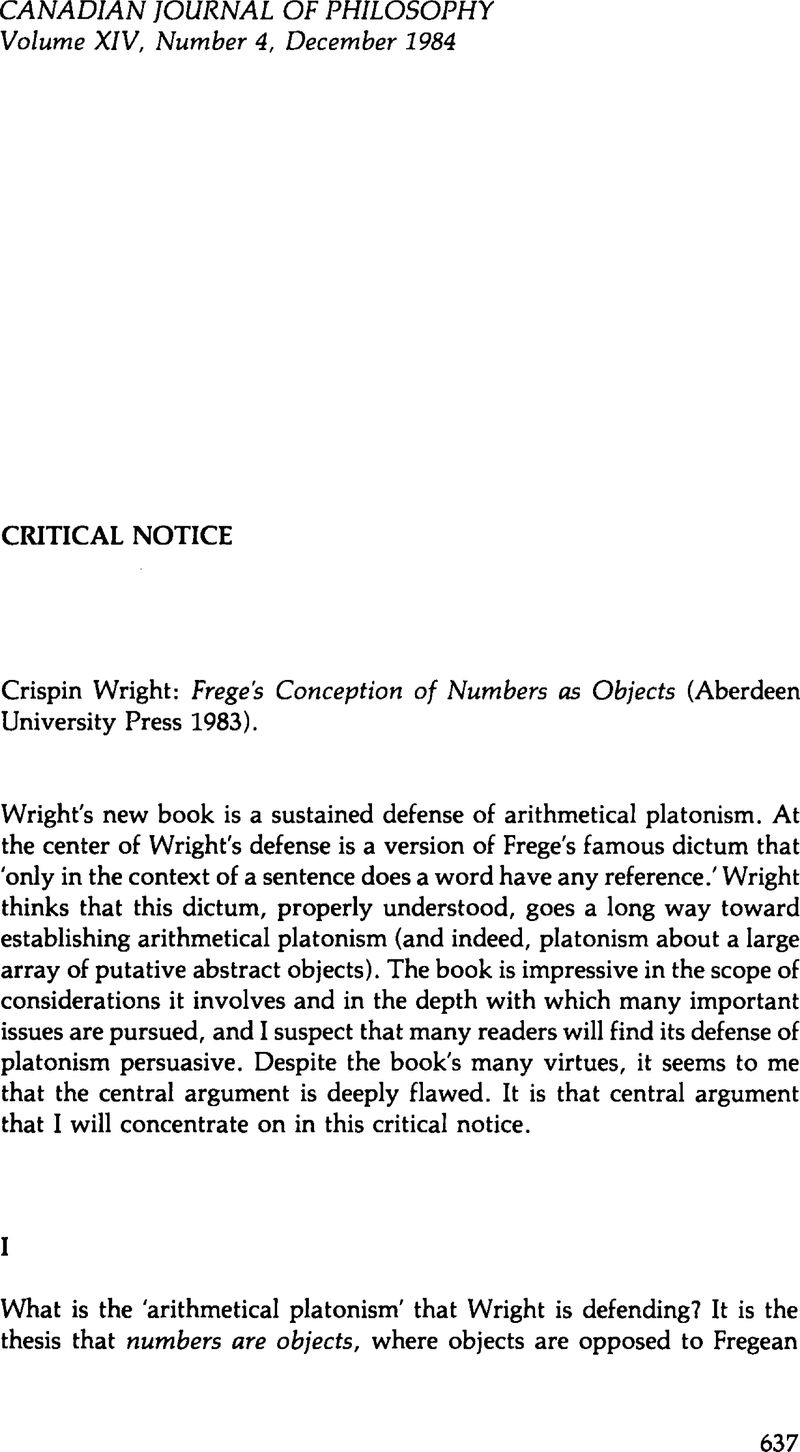Article contents
Crispin Wright: Frege's Conception of Numbers as Objects (Aberdeen University Press 1983).
Review products
Published online by Cambridge University Press: 01 January 2020
Abstract

- Type
- Critical Notice
- Information
- Copyright
- Copyright © Taylor & Francis Group, LLC 1984
References
1 Or, the part of his discussion which in my reconstruction is relevant to claim (0). My numbered theses do not actually appear in Wright's book in so many words.
2 We must of course be able to explain the connection between (i) and (i’), but this can be done without attributing to ‘three’ the same logical form in both sentences. (For instance, one could hold that ‘three’ is a singular term in (i’) but not in (i), but that (i’) and (i) are logically equivalent. This is not the only possibility, however, and I will ultimately be defending another one.)
3 See Footnote 4 to Wright's Section II (171).
4 It is important to bear in mind that on Wright's view sets as well as directions and numbers are to be introduced by abstraction. Otherwise, one may mistakenly suppose that when Wright talks about introducing directions or numbers by abstraction, he is assuming that sets are antecedently available and that the goal of the abstraction is simply to find some of these antecedently available sets to serve as directions or numbers. To make this supposition would be to totally misconceive Wright's project, as Wright says very explicitly (150).
5 This assumption follows from the policy on atomic statements discussed in Section II. (For from (ζ=) we get ﹛x| A(x)﹜ = ﹛x| A(x)﹜ ↔ ∀ x (A(x) ↔ A(x)); therefore ﹛x| A(x)﹜ = ﹛x| A(x)﹜, and so by the policy on atomic statements, ∃y (y= ﹛x| A(x)﹜).)
6 Dale Gottlieb, Ontological Economy: Substitutional Quantification and Mathematics (Oxford: Oxford University Press 1980), 92
7 More accurately, AN is a conservative extension of the theory N* that results from restricting all free variables and quantifiers of N by the clause ‘is not a direction’ (or ‘is not a number,’ etc.). (N* is an agnostic version of N: N may presuppose in its unspecified laws that there are no directions (or numbers, etc.), and N* removes any such presupposition.) By the same token, ‘parallelism theory’ should really be taken as a name of N*, not of N. I have ignored the need of shifting from N to N* in the text only for simplifying the exposition.
8 That is, if p1’ …., Pn q are such claims, and direction theory plus p1’ …, Pn logically entail q, then parallelism theory plus p1, …, Pn logically entail q.
9 Nor, he apparently thinks, is there any need to maintain with Quine and Putnam that the existence of mathematical entitities is supported in the same way as the existence of theoretical entities in science is supported: i.e., by an argument that they are indispensable in physical theory.
10 Or at least, (a) is a logical consequence of (a’) plus parallelism theory. (Parallelism theory, not direction theory.) This weaker claim is more plausible since it does not require that parallelism theory itself consist of logical truths, and I suspect that it is a more accurate reflection of Wright's real position than the claim that (a) is logically equivalent to (a’). I have ignored this in the text, to make my formulations sound more like Wright's formulations; note, however, that the crucial claim (L) below is formulated so as to be neutral between the stronger and weaker claims.
11 Or, of the existence of lines plus parallelism theory - see note 10.
12 Supplement A to Carnap's Meaning and Necessity (Chicago: University of Chicago Press 1956)
- 30
- Cited by




